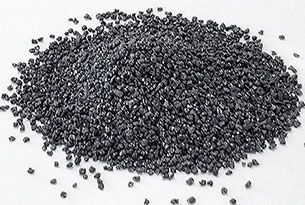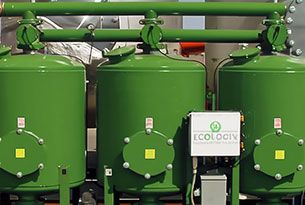Summary
Pharmaceuticals such as antibiotics, hormones, and pain relievers enter our water systems through human excretion and improper disposal like flushing. Hormones can act as endocrine disruptors, posing ecosystem risks. Wastewater treatments including chlorine and UV provide varying levels of removal, but not always total elimination. These contaminants now appear in our drinking water and food chains at very low levels. Key concerns we have involve antibiotic resistance and the impact on wildlife. Efforts to address this issue include regulations banning hazardous med flushing, which will make little difference in the real world, and tertiary wastewater treatment design considerations.
Introduction
Emerging contaminants pose a significant challenge in water management. Pharmaceuticals, including antibiotics, hormones, and pain relievers, are detected more frequently in water sources thanks to improved analytical methods. Some act as endocrine disruptors, disrupting hormonal systems in aquatic life and possibly human health. This article reviews pharmaceuticals entering wastewater via excretion or improper disposal, their persistence, treatment effectiveness, and infiltration into water and food supplies.
What Are Emerging Contaminants? Focusing on Pharmaceuticals
Emerging contaminants, or contaminants of emerging concern (CECs), encompass chemicals detected at low levels in water that were previously overlooked. Pharmaceuticals and personal care products (PPCPs) form a significant category within CECs [1]. As defined by the U.S. Environmental Protection Agency (EPA), "Contaminants of emerging concern (CECs), including pharmaceuticals and personal care products (PPCPs), are increasingly being detected at low levels in surface water" [1]. These include prescription and over-the-counter medications.
Common types extend beyond antibiotics, hormones, and pain relievers to include antidepressants, anticonvulsants, beta-blockers, antihypertensives, antiepileptics, antidiabetics, and lipid regulators [4][28]. For instance, the U.S. Geological Survey (USGS) notes that "Emerging contaminants, or contaminants of emerging concern, can refer to many different kinds of chemicals, including medicines, personal care or household cleaning products, lawn care and agricultural products, among others" [2]. Some, like certain hormones, are endocrine disruptors that can alter reproductive functions in wildlife [7].
How Pharmaceuticals Enter Water Systems
Pharmaceuticals primarily reach water systems via human use and disposal practices [3].
Excretion vs. Metabolism: What Passes Through the Body?
Upon ingestion, pharmaceuticals undergo metabolism (breakdown into inactive forms) or excretion (passage in unchanged or partially altered states). Many are not fully neutralized; for example, antibiotics may be excreted 30-90% unchanged in urine or feces [3]. Hormones such as ethinylestradiol from contraceptives are excreted 20-50% intact, while pain relievers like ibuprofen see about 15% unchanged excretion [3]. Acetaminophen, however, is largely metabolized (up to 95%) [3]. These processes occur within hours to days, directing compounds into wastewater via sewage systems.
Improper Disposal: Contributing to the Problem
Disposing of unused or expired medications by flushing them introduces active compounds directly into wastewater [10]. The Food and Drug Administration (FDA) advises against this, stating in guidance documents that improper disposal can lead to environmental release, though specific quotes from FDA materials emphasize proper waste handling to minimize impacts [27]. Once in water, degradation varies; antibiotics may persist for 1-7 days, while hormones can last longer [11].
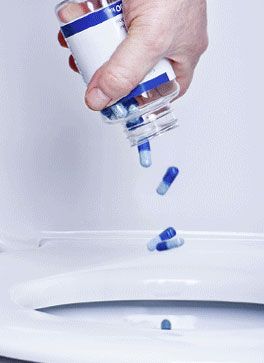
Key Pharmaceuticals of Concern
The following table summarizes key pharmaceutical types, their examples, excretion rates, persistence, endocrine disruption potential, and concern levels, based on environmental impacts [1][2][4][6].
| Pharmaceutical Type | Examples | % Excreted Unchanged | Deterioration Time in Water | Endocrine Disruptor? | Concern Level | Notes |
|---|---|---|---|---|---|---|
| Antibiotics | Ciprofloxacin, Sulfamethoxazole | 30-90% | 1-5 days | No | High | Promotes antibiotic resistance; "Antibiotics are another frequently-prescribed class of API that negatively impact ecosystems. Antibiotics are designed to kill living organisms" [6]. |
| Hormones | Ethinylestradiol, Estradiol | 20-50% | 5-10 days | Yes | Very High | Disrupts reproduction in aquatic life [7]. |
| Pain Relievers | Ibuprofen, Acetaminophen | 5-15% | 2-7 days | Sometimes | Medium | Affects invertebrates and algae [3]. |
| Antidepressants | Fluoxetine, Sertraline, Venlafaxine | 10-30% | 3-14 days | Yes (some) | High | Bioaccumulates in fish, altering behavior; commonly detected (78%) [4]. |
| Anticonvulsants | Carbamazepine | 1-5% | 10-30 days | No | Medium-High | Highly persistent; commonly detected (78%) [4]. |
| Beta-Blockers | Atenolol, Metoprolol | 50-90% | 2-5 days | No | Medium | Impacts cardiovascular functions in fish [4]. |
| Antihypertensives | Losartan, Valsartan | 10-40% | 5-15 days | No | Medium | Contributes to overall PPCP load [4]. |
| Antidiabetics | Metformin | 90-100% | 5-20 days | No | Medium | Frequently detected in streams; affects aquatic organisms [28]. |
| Lipid Regulators | Atorvastatin | 5-10% | 7-15 days | Sometimes | Medium | Common in wastewater; potential endocrine effects [28]. |
Processes at Wastewater Treatment Plants
Conventional wastewater treatment plants (WWTPs) are not optimized for pharmaceutical removal, resulting in variable efficacy [8].
Neutralization by Chlorine and UV: Effectiveness and Limitations
Chlorine disinfection removes 50-90% of some antibiotics but only 20-40% of hormones [9]. However, it can create byproducts: Chlorine reacts with organic compounds, including pharmaceuticals, forming disinfection byproducts (DBPs) such as trihalomethanes (THMs) and haloacetic acids (HAAs), which are regulated due to potential carcinogenicity [17][21]. The EPA notes, "Chlorination can produce chlorinated disinfection byproducts of the ECs" [21]. UV treatment fares better for hormones (up to 80% removal) but less for pain relievers; combined UV/chlorine enhances results [9].
Pros and Cons of Treatments
- Pros: Chlorine is cost-effective and bactericidal; UV avoids chemical addition.
- Cons: Incomplete removal; UV is energy-intensive; chlorine forms harmful DBPs [17].
Equation Example: Removal Efficiency
Removal % = [(Influent Concentration - Effluent Concentration) / Influent Concentration]
x 100
Example for ibuprofen: (10 μg/L - 2 μg/L) / 10 μg/L x 100 = 80% (based on kinetic models;
rate constant k in d-1 varies by compound) [8].
Additional Equation: First-Order Decay Kinetics
C_t = C_0 * e^(-k*t), where C_t is concentration at time t, C_0 initial concentration, k decay rate (d-1), t time (days). For carbamazepine, k ≈ 0.02 d-1 in surface water [11].
Deterioration Over Time: Persistence in the Environment
In WWTPs, antibiotics degrade in 1-3 days, hormones in 3-7 days, but persistent ones like carbamazepine last longer [11].
Case Study: A USGS study detected pharmaceuticals in 80% of U.S. streams, with WWTP upgrades reducing levels by 50-70% [13]. A direct quote from the study: "In Phase II, 47 different pharmaceuticals were detected in all source-water samples, with a maximum of 41 pharmaceuticals detected in any one sample. The median number of pharmaceuticals for all 25 samples was eight." [28].
Why It Matters: Impacts on Water, Food, and Ecosystems
Pharmaceuticals pose risks beyond detection.
Entry into Drinking Water and the Food Chain
Low concentrations (ng/L) appear in drinking water post-treatment [12]. They enter food via crop irrigation or bioaccumulation in fish [12]. USGS reports, "Pharmaceuticals common in small streams in the U.S." [7].
Critical Issues Requiring Attention
Hormones cause intersex conditions in fish [7]. Antibiotics foster resistance [6]. Chronic exposure may have subtle human health effects, though risks are considered low [1]. Research shows negative effects on aquatic ecosystems [28].
Current Actions: Solutions and Regulations
Efforts include regulations and design. The EPA's 2019 rule prohibits flushing hazardous pharmaceuticals, treating them as waste [14]. Recent updates via the Clean Water State Revolving Fund address CECs (2022) [15]. Ecologix Environmental Systems will use advanced treatments like ozone or activated carbon to achieve 90%+ removal [8]. Case Study: EPA's Columbia River initiative reduced PPCPs by 70% through upgrades [16]. Ozone is effective (90-99% removal) but costly; activated carbon adsorbs well but requires media replacement [5].
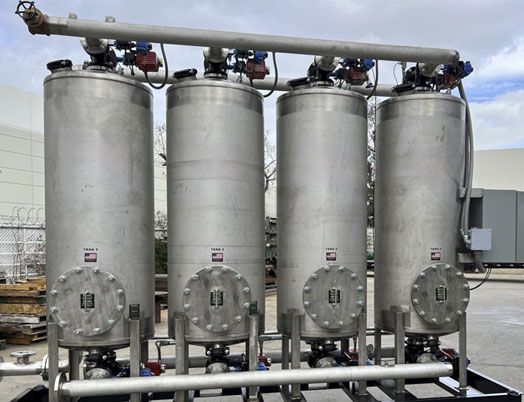
Conclusion
Our use of medicines is leaving an unwelcome residue in our water. Prescription drugs frequently escape our traditional wastewater systems. This oversight poses tangible threats: aquatic life suffers reproductive harm, and the specter of antibiotic-resistant superbugs looms larger. While some rules exist to prevent improper disposal, their effectiveness is limited to personal compliance. The real solution lies in embracing tertiary water purification methods such as activated carbon filtration and ozone systems.
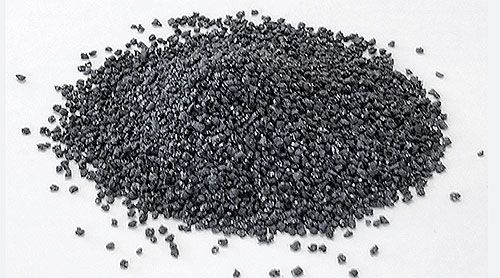
FAQ
Q: Which pharmaceuticals are most concerning as endocrine disruptors?
A: Hormones like ethinylestradiol, which interfere with aquatic reproduction [7].
Q: Does chlorine fully remove antibiotics from wastewater?
A: No, removal is 50-90%, with advanced methods improving outcomes [9].
Q: How do pharmaceuticals enter the food chain?
A: Via irrigated crops or bioaccumulation in contaminated fish [12].
Q: What is the recommended disposal method for unused medications?
A: Participate in take-back programs or mix with unappealing substances before trashing—avoid flushing [10].
Q: Does Ecologix design or sell systems for removing pharmaceuticals from the water?
A: Yes.
Ready to Optimize Your Water Treatment?
Connect with Ecologix Systems today to discuss your specific needs and discover how our advanced solutions can enhance your operations.
Contact Our Experts NowGlossary
API: Active Pharmaceutical Ingredients - The biologically active components in medications.
CAS: Chemical Abstracts Service - A registry providing unique numerical identifiers for chemical substances.
CECs: Contaminants of Emerging Concern - Pollutants like PPCPs newly identified in water.
DBPs: Disinfection Byproducts - Compounds formed during water treatment processes, often from chlorine reactions.
ECs: Emerging Contaminants - Substances of recent environmental concern, synonymous with CECs.
EPA: U.S. Environmental Protection Agency - Federal agency responsible for protecting human health and the environment.
Endocrine Disruptors: Substances that interfere with hormonal functions in organisms.
FDA: U.S. Food and Drug Administration - Agency regulating food, drugs, and medical devices.
HAAs: Haloacetic Acids - A class of disinfection byproducts formed during chlorination, potentially harmful.
ng/L: Nanograms per liter - A unit measuring very low concentrations of contaminants in water.
PPCPs: Pharmaceuticals and Personal Care Products - Medications and hygiene items detected in environments.
THMs: Trihalomethanes - A group of disinfection byproducts associated with health risks like carcinogenicity.
USGS: U.S. Geological Survey - Federal agency providing scientific information on natural resources and hazards.
UV: Ultraviolet - A form of electromagnetic radiation used in water disinfection and treatment.
WWTP: Wastewater Treatment Plant - Facilities designed for the purification of sewage and wastewater.
μg/L: Micrograms per liter - A unit for measuring trace contaminant concentrations in water.
d-1: Days inverse - Unit for rate constants in kinetic models, indicating per day.
Bibliography
- [1] https://www.epa.gov/wqc/contaminants-emerging-concern-including-pharmaceuticals-and-personal-care-products
- [2] https://www.usgs.gov/mission-areas/water-resources/science/emerging-contaminants
- [3] https://www.ncbi.nlm.nih.gov/books/NBK442023/
- [4] https://www.epa.gov/sites/default/files/2018-08/documents/cec_article_from_sciencedirect.pdf
- [5] https://www.epa.gov/system/files/documents/2024-08/ppcp-technology-brief.pdf
- [6] https://www.epa.gov/household-medication-disposal/impact-pharmaceuticals-released-environment
- [7] https://www.usgs.gov/news/pharmaceuticals-common-small-streams-us
- [8] https://www.usgs.gov/special-topics/water-science-school/science/pharmaceuticals-water
- [9] https://cfpub.epa.gov/si/si_public_file_download.cfm?p_download_id=490550
- [10] https://www.fda.gov/media/139220/download
- [11] https://pubs.usgs.gov/sir/2009/5119/pdf/sir20095119.pdf
- [12] https://www.usgs.gov/special-topics/water-science-school/science/pharmaceuticals-water
- [13] https://pubs.usgs.gov/sir/2012/5083/pdf/2012-5083.pdf
- [14] https://www.epa.gov/hwgenerators/management-hazardous-waste-pharmaceuticals
- [15] https://www.epa.gov/cwsrf/clean-water-state-revolving-fund-emerging-contaminants
- [16] https://www.epa.gov/endocrine-disruption/overview-endocrine-disruption
- [17] https://www.epa.gov/system/files/documents/2024-08/ppcp-technology-brief.pdf
- [18] https://www.ncbi.nlm.nih.gov/books/NBK547662/
- [19] https://www.epa.gov/sites/default/files/2018-11/documents/cecs-ppcps-factsheet.pdf
- [20] https://cfpub.epa.gov/ncer_abstracts/index.cfm/fuseaction/display.abstractDetail/abstract_id/1066/report/F
- [21] https://cfpub.epa.gov/si/si_public_file_download.cfm?p_download_id=490550
- [22] https://www.epa.gov/ground-water-and-drinking-water/national-primary-drinking-water-regulations
- [23] https://www.epa.gov/npdes/stormwater-pollutants-emerging-concern
- [24] https://www.epa.gov/cwsrf/cwsrf-emerging-contaminants-frequent-questions-and-answers
- [25] https://www.epa.gov/water-research/treatment-and-control-drinking-water-contaminants-research
- [26] https://www.epa.gov/eg/pharmaceutical-manufacturing-effluent-guidelines
- [27] https://www.fda.gov/media/139220/download
- [28] https://pmc.ncbi.nlm.nih.gov/articles/PMC7017633/
